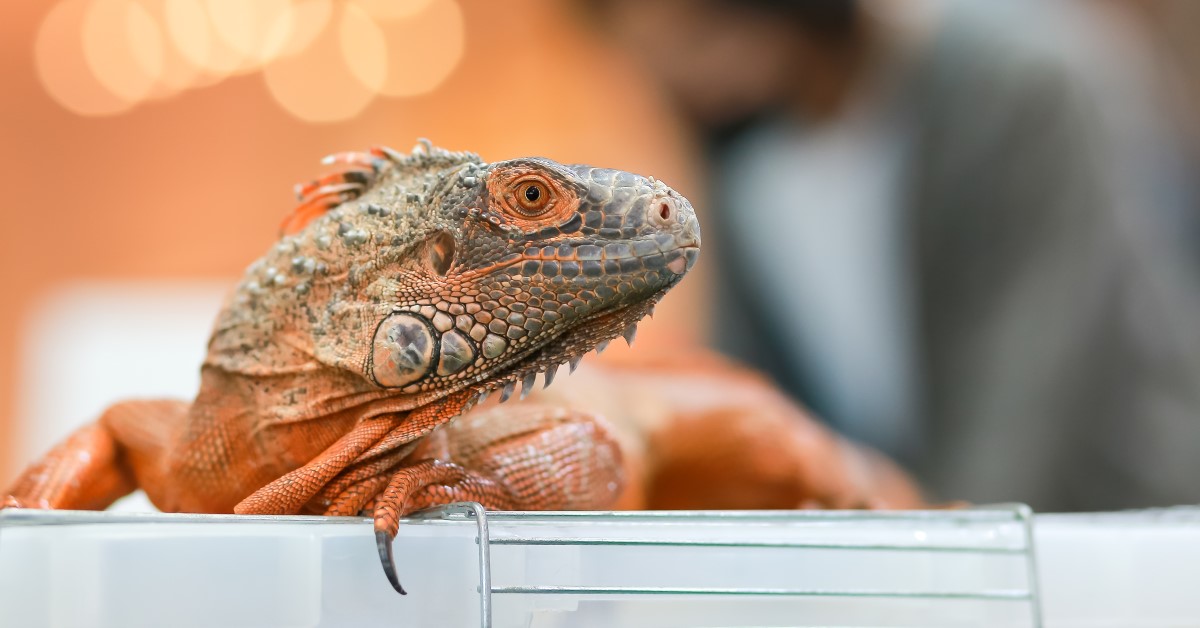10 Fun Facts You Didn't Know About Geckos
Find out interesting and sometimes weird things you didn’t know about geckos.

Did you know that geckos can change colors, similar to chameleons? Did you know some species can glide like flying squirrels? Or how about the fact that they can shed their skin in one piece? These are just a few fun facts about geckos you might not have known. Let’s uncover some other interesting things about these small lizards and what you can expect if you choose to adopt a gecko.
1. There Are Over 1,000 Species of Geckos (And Counting)
Geckos represent a hugely diverse group of lizards. Scientists estimate more than 1,000 species across six families. From tiny dwarf geckos that fit on your fingertip to the giant day geckos of Madagascar, they can be found in an astonishing variety of sizes, colors, and habitats.
2. Geckos Have Sticky Feet
One of the most famous gecko traits is the ability to walk upside down, on ceilings, and scale glass like it’s nothing. But how? Their toe pads are covered in millions of microscopic hair-like structures called setae, which split into even tinier branches known as spatulae. Those structures let geckos effortlessly stick to surfaces. In fact, NASA has studied gecko adhesion to develop novel materials for space robots.
Geckos don’t just defy gravity but they do it silently. Unlike suction cups or claws, their unique foot structure allows them to move without making a sound. This stealthy advantage is crucial for sneaking up on insects or slipping away from predators unnoticed. Even more impressive, geckos can adjust how “sticky” their toes are simply by changing the angle of their feet.
3. Geckos See Better in Darkness Than You Do
Geckos are mostly nocturnal, and their vision is built for the night. Their eyes are reportedly 350 times more sensitive to light than human eyes. In low light, geckos can still discern colors due to modified cone cells, a rare feat among vertebrates.
4. Geckos Lick Their Own Eyeballs
Unlike many animals, geckos do not have movable eyelids. So how do they keep their eyes clean? They use their tongues! Many geckos lick their eyes to wipe away dust or debris. It may seem strange, but it’s an effective solution to maintaining vision in dusty environments.
5. Self-Amputation Is a Sneaky Escape Move
Geckos are known to perform one of the wildest survival tricks in the reptile world. When threatened, a gecko can perform caudal autotomy, dropping its tail at a pre-designed break plane to distract a predator. While the predator chases the wiggling tail, the gecko bolts. That said, losing a tail isn’t without cost. Tail loss alters a gecko’s center of mass and slows it temporarily.
6. Geckos Regrow Their Tails Fast
Now for the really amazing part. Many gecko species can regenerate their lost tails, often within just 30 days. The new tail is structurally different (a tube of cartilage rather than bone) and may lack the full segmentation of the original.
Inside that regrowth process, neural stem or progenitor cells spring into action, rebuilding spinal tissues and nerve connections. This trait has drawn attention from medical researchers hoping to glean clues for spinal injury therapies.
7. The Tail Is Also a Fat Bank
When not being used as a decoy, a gecko tail often moonlights as a fat storage organ. For species where food isn’t always reliable, such as desert dwellers, that extra energy is critical. That’s one more reason losing the tail is a big deal beyond just defense.
8. Geckos Are Quite Vocal (For Lizards)
You might not expect a lizard to be chatty, but several gecko species produce sounds, such as chirps, clicks, barks, even croaks. The tokay gecko, for example, gets its name from the loud “to-kay” call it makes at night. These vocalizations serve functions like territory marking, mating calls, and neighbor recognition.
What’s even more fascinating is that geckos have distinct “dialects” depending on their species and region. Some communicate in short bursts, while others use rhythmic patterns or repetitive calls to signal their intentions. Researchers studying these vocalizations believe geckos may be capable of a basic form of acoustic learning, an ability once thought to belong only to birds and mammals. It’s a reminder that even small reptiles have surprisingly complex ways of expressing themselves.
9. Geckos Exhibit Social IQ
Contrary to the image of solitary reptiles, many geckos display social behaviors. They use pheromones and scent cues to recognize others, defend territories, and interact with potential mates. Some species, such as tokays, even form rudimentary family units, including both parents caring for young.
Geckos also show problem-solving skills. Captive studies suggest they can navigate complex enclosures or find hidden prey, showing adaptability above mere instinct.
10. Geckos Live Almost Everywhere Except Antarctica
Geckos are cosmopolitan. You’ll find them in tropical rainforests, desert dunes, temperate woodlands, and even urban homes. However, Antarctica remains gecko-free. Some species are even invasive in new territories, using human structures as perfect gecko real estate.
There’s More to Geckos Than Meets the Eye
Geckos might be small, but their biology is anything but simple. From their super-sticky feet to their tail-regeneration abilities and social smarts, these lizards continue to surprise scientists and pet lovers alike. They may be small, but geckos prove that the tiniest creatures often have the biggest surprises.
Ready to start saving money on pet wellness care?
Then take a look at Mint Wellness, the pet wellness plan that provides fast reimbursement on routine pet care. Save on vaccinations, wellness exams, preventatives, dental, and more!
Learn More

